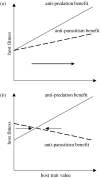Cuckoos, cowbirds and hosts: adaptations, trade-offs and constraints
- PMID: 17827098
- PMCID: PMC2442387
- DOI: 10.1098/rstb.2006.1849
Cuckoos, cowbirds and hosts: adaptations, trade-offs and constraints
Abstract
The interactions between brood parasitic birds and their host species provide one of the best model systems for coevolution. Despite being intensively studied, the parasite-host system provides ample opportunities to test new predictions from both coevolutionary theory as well as life-history theory in general. I identify four main areas that might be especially fruitful: cuckoo female gentes as alternative reproductive strategies, non-random and nonlinear risks of brood parasitism for host individuals, host parental quality and targeted brood parasitism, and differences and similarities between predation risk and parasitism risk. Rather than being a rare and intriguing system to study coevolutionary processes, I believe that avian brood parasites and their hosts are much more important as extreme cases in the evolution of life-history strategies. They provide unique examples of trade-offs and situations where constraints are either completely removed or particularly severe.
Figures





Similar articles
-
The common redstart as a suitable model to study cuckoo-host coevolution in a unique ecological context.BMC Evol Biol. 2016 Nov 25;16(1):255. doi: 10.1186/s12862-016-0835-5. BMC Evol Biol. 2016. PMID: 27887566 Free PMC article.
-
Long-term coevolution between avian brood parasites and their hosts.Biol Rev Camb Philos Soc. 2014 Aug;89(3):688-704. doi: 10.1111/brv.12075. Epub 2013 Dec 14. Biol Rev Camb Philos Soc. 2014. PMID: 24330159
-
Brood parasitism selects for no defence in a cuckoo host.Proc Biol Sci. 2011 Sep 22;278(1719):2777-83. doi: 10.1098/rspb.2010.2629. Epub 2011 Feb 2. Proc Biol Sci. 2011. PMID: 21288944 Free PMC article.
-
Polymorphism at the nestling stage and host-specific mimicry in an Australasian cuckoo-host arms race.J Anim Ecol. 2023 Jan;92(1):30-43. doi: 10.1111/1365-2656.13849. Epub 2022 Dec 11. J Anim Ecol. 2023. PMID: 36426636 Review.
-
Colour, vision and coevolution in avian brood parasitism.Philos Trans R Soc Lond B Biol Sci. 2017 Jul 5;372(1724):20160339. doi: 10.1098/rstb.2016.0339. Philos Trans R Soc Lond B Biol Sci. 2017. PMID: 28533456 Free PMC article. Review.
Cited by
-
Egg phenotype matching by cuckoos in relation to discrimination by hosts and climatic conditions.Proc Biol Sci. 2012 May 22;279(1735):1967-76. doi: 10.1098/rspb.2011.2498. Epub 2012 Jan 11. Proc Biol Sci. 2012. PMID: 22237911 Free PMC article.
-
Fine-scale plasticity in nest placement can compensate for poor quality junipers as nesting trees for gray vireos.PeerJ. 2021 Nov 9;9:e12477. doi: 10.7717/peerj.12477. eCollection 2021. PeerJ. 2021. PMID: 34820199 Free PMC article.
-
Larval settlement: the role of surface topography for sessile coral reef invertebrates.PLoS One. 2015 Feb 11;10(2):e0117675. doi: 10.1371/journal.pone.0117675. eCollection 2015. PLoS One. 2015. PMID: 25671562 Free PMC article.
-
Nest prospecting brown-headed cowbirds 'parasitize' social information when the value of personal information is lacking.Proc Biol Sci. 2017 Aug 30;284(1861):20171083. doi: 10.1098/rspb.2017.1083. Proc Biol Sci. 2017. PMID: 28835558 Free PMC article.
-
Egg colour mimicry in the common cuckoo Cuculus canorus as revealed by modelling host retinal function.Proc Biol Sci. 2008 Oct 22;275(1649):2345-52. doi: 10.1098/rspb.2008.0720. Proc Biol Sci. 2008. PMID: 18595836 Free PMC article.
References
-
- Alderson G.W, Gibbs H.L, Sealy S.G. Determining the reproductive behaviour of individual brown-headed cowbirds using microsatellite DNA markers. Anim. Behav. 1999;58:895–905. doi:10.1006/anbe.1999.1220 - DOI - PubMed
-
- Alvarez F. Proximity of trees facilitates parasitism by cuckoos Cuculus canorus on rufous warblers Cercotrichas galactotes. Ibis. 1993;135:331.
-
- Amundsen T, Brobakken P.T, Moksnes A, Røskaft E. Rejection of common cuckoo Cuculus canorus eggs in relation to female age in the bluethroat Luscinia svecica. J. Avian Biol. 2002;33:366–370. doi:10.1034/j.1600-048X.2002.02894.x - DOI
-
- Aragon S, Møller A.P, Soler J.J, Soler M. Molecular phylogeny of cuckoos supports a polyphyletic orgin of brood parasitism. J. Evol. Biol. 1999;12:495–506. doi:10.1046/j.1420-9101.1999.00052.x - DOI
-
- Arcese P, Smith J.N.M, Hatch M.I. Nest predation by cowbirds and its consequences for passerine demography. Proc. Natl Acad. Sci. USA. 1996;93:4608–4611. doi:10.1073/pnas.93.10.4608 - DOI - PMC - PubMed
Publication types
MeSH terms
LinkOut - more resources
Full Text Sources

